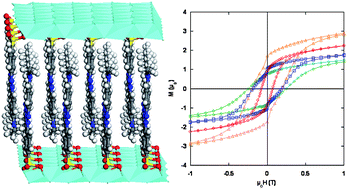New layered organic-inorganic magnets incorporating azo dyes†
Abstract
New hybrid organic/inorganic magnets have been synthesized by insertion of stilbazolium-carboxylate and/or -sulfonate

* Corresponding authors
a
Institut de Physique et Chimie des Matériaux de Strasbourg, UMR 7504 CNRS - Université de Strasbourg, 23 rue du Loess, BP 43, Strasbourg, Cedex 2, France
E-mail:
rabu@ipcms.u-strasbg.fr, rogez@ipcms.u-strasbg.fr
Fax: (+33) (0)3 88 10 72 47
b Laboratoire de Physique de l'État Condensé, Institut de Recherche en Ingénierie Moléculaire et Matériaux Fonctionnels, Faculté des Sciences/Université du Maine, Le Mans, Cedex 9, France
New hybrid organic/inorganic magnets have been synthesized by insertion of stilbazolium-carboxylate and/or -sulfonate

 Please wait while we load your content...
Something went wrong. Try again?
Please wait while we load your content...
Something went wrong. Try again?
É. Delahaye, S. Eyele-Mezui, J. Bardeau, C. Leuvrey, L. Mager, P. Rabu and G. Rogez, J. Mater. Chem., 2009, 19, 6106 DOI: 10.1039/B905557F
To request permission to reproduce material from this article, please go to the Copyright Clearance Center request page.
If you are an author contributing to an RSC publication, you do not need to request permission provided correct acknowledgement is given.
If you are the author of this article, you do not need to request permission to reproduce figures and diagrams provided correct acknowledgement is given. If you want to reproduce the whole article in a third-party publication (excluding your thesis/dissertation for which permission is not required) please go to the Copyright Clearance Center request page.
Read more about how to correctly acknowledge RSC content.
 Fetching data from CrossRef.
Fetching data from CrossRef.
This may take some time to load.
Loading related content
